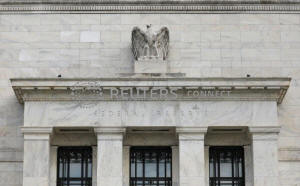|
Fed likely to resist pressure to cut U.S.
rates this week
 Send a link to a friend
Send a link to a friend
 [June 17, 2019]
By Ann Saphir and Howard Schneider [June 17, 2019]
By Ann Saphir and Howard Schneider
SAN FRANCISCO/WASHINGTON (Reuters) - The
U.S. Federal Reserve, facing fresh demands by President Donald Trump to
cut interest rates, is expected to leave borrowing costs unchanged at a
policy meeting this week but possibly lay the groundwork for a rate cut
later this year.
New economic projections that will accompany the U.S. central bank's
policy statement on Wednesday will provide the most direct insight yet
into how deeply policymakers have been influenced by the U.S.-China
trade war, Trump's insistence on lower interest rates, and recent weaker
economic data.
Analysts expect the "dot plot" of year-end forecasts for the Fed's
benchmark overnight lending rate - the federal funds rate - will show a
growing number of policymakers are open to cutting rates in the coming
months, though nowhere near as aggressively as investors expect or Trump
wants.
The Fed is also widely, though not universally, expected to remove a
pledge to be "patient" in taking future action on rates, opening the
door to a possible cut at its coming policy meetings.

Risks may be rising, but "I don't think they want to box themselves into
a corner," said Carl Tannenbaum, chief economist at Northern Trust. "The
markets are set up for a cut in July, and if they donít get it,
financial conditions will tighten."
The federal funds rate is currently set in a range of 2.25% to 2.50%.
The Fed's policy-setting committee is due to release its latest
statement and economic projections at 2 p.m. EDT (1800 GMT) on Wednesday
after the end of a two-day meeting. Fed Chairman Jerome Powell will hold
a press conference shortly after.
MIND THE DOTS
The Fed's last set of economic and policy projections, released in
March, showed most policymakers foresaw no need to change rates this
year and only very gradual rate hikes thereafter. (For a graphic of the
gap between market and Fed expectations, please see https://tmsnrt.rs/2WzJ6tu.)
But since that meeting the economic outlook has become cloudier.
Recent U.S. retail sales numbers were strong. But while unemployment has
held near a 50-year low of 3.6%, U.S. employers created a paltry 75,000
jobs in May. Inflation, which Powell says is low in part because of
temporary factors, continues to undershoot the Fed's 2% target.
The Atlanta Fed forecast on Friday that gross domestic product will
increase at a 2.1 percent annualized rate in the April-June quarter, a
drop from the 3.1 percent pace of the first three months of the year.
Trade uncertainty has increased as well, with Trump using the threat of
tariffs on goods from Mexico to force the country to curb the number of
mostly Central American immigrants crossing the U.S.-Mexico border.
He has also vowed to slap more tariffs on Chinese imports if no trade
deal is reached when he meets Chinese President Xi Jinping at a Group of
20 summit at the end of this month in Japan.
Concern that mounting tariffs could further slow U.S. and global
economic growth is one of the chief reasons traders in interest rate
futures loaded up on contracts anticipating three U.S. rate cuts by the
end of the year.
Fed officials may have reason to trim their rate outlook a bit, but
meeting market expectations would involve a dramatic shift. Nine of the
Fed's current 17 policymakers would have to move their rate projections
downward for the median to reflect a single cut, let alone three.
[to top of second column]
|

The Federal Reserve building is pictured in Washington, DC, U.S.,
August 22, 2018. REUTERS/Chris Wattie/File Photo

"Powell will do what he can to try to downplay the dots especially
if they donít show what the markets want them to show," said Roberto
Perli, economist at Cornerstone Macro. "He will have a tough time."
Adding to the pressure for a rate cut is a yield curve inversion in
parts of the market for U.S. government debt, historically a
precursor of recessions. The three-month Treasury bill, for
instance, has paid out a higher rate than a 5-year Treasury note for
the last several months running.
And Trump, who has said that rates should be lowered by perhaps a
full percentage point or more, continues to publicly berate the Fed
and Powell, his handpicked chairman, for refusing to act.
"I've waited long enough," Trump said in an interview with ABC News
last week, talking favorably of the "old days" when Presidents
Lyndon Johnson and Richard Nixon intervened forcefully in Fed policy
- and set the stage, many economists argue, for the high inflation,
economic volatility and recessions that followed in the 1970s.
DOWNWARD SHIFT
Most of the more than 100 economists polled June 7-12 by Reuters say
they are not penciling in a rate cut until the third quarter of next
year. But views are shifting rapidly. Forty respondents expected at
least one rate cut sometime in 2019, up from just eight who did in
the previous poll.
Within the U.S. central bank, St. Louis Fed President James Bullard
is the only policymaker who has said a rate cut may be needed
"soon."

Several others have signaled a readiness to move off their
wait-and-see stance, with Powell saying earlier this month in a
speech in Chicago that the Fed will act "as appropriate" in the face
of risks posed by the global trade war and other developments.
The word "patient," which had been repeatedly used by the Fed since
early this year to signal its willingness to hold off further rate
hikes, was notably absent from Powell's remarks, though the Fed
chief stopped well short of suggesting a rate cut was coming soon.
The Fed raised rates four times in 2018 but has since abandoned
plans to continue lifting borrowing costs this year.
It is likely to avoid signaling any move to cut rates until it is
ready to deliver, predicted Bruce Monrad, a high-yield bond
portfolio manager at Boston-based Northeast Investors Trust.
Nevertheless, Monrad added, Fed policymakers may have tied their own
hands by letting bets in financial markets stray so far. "They have
had six months to control the rhetoric. They really haven't walked
back the market."
(Reporting by Ann Saphir and Howard Schneider; Editing by Paul Simao)
[© 2019 Thomson Reuters. All rights
reserved.]
Copyright 2019 Reuters. All rights reserved. This material may not be published,
broadcast, rewritten or redistributed.
Thompson Reuters is solely responsible for this content. |